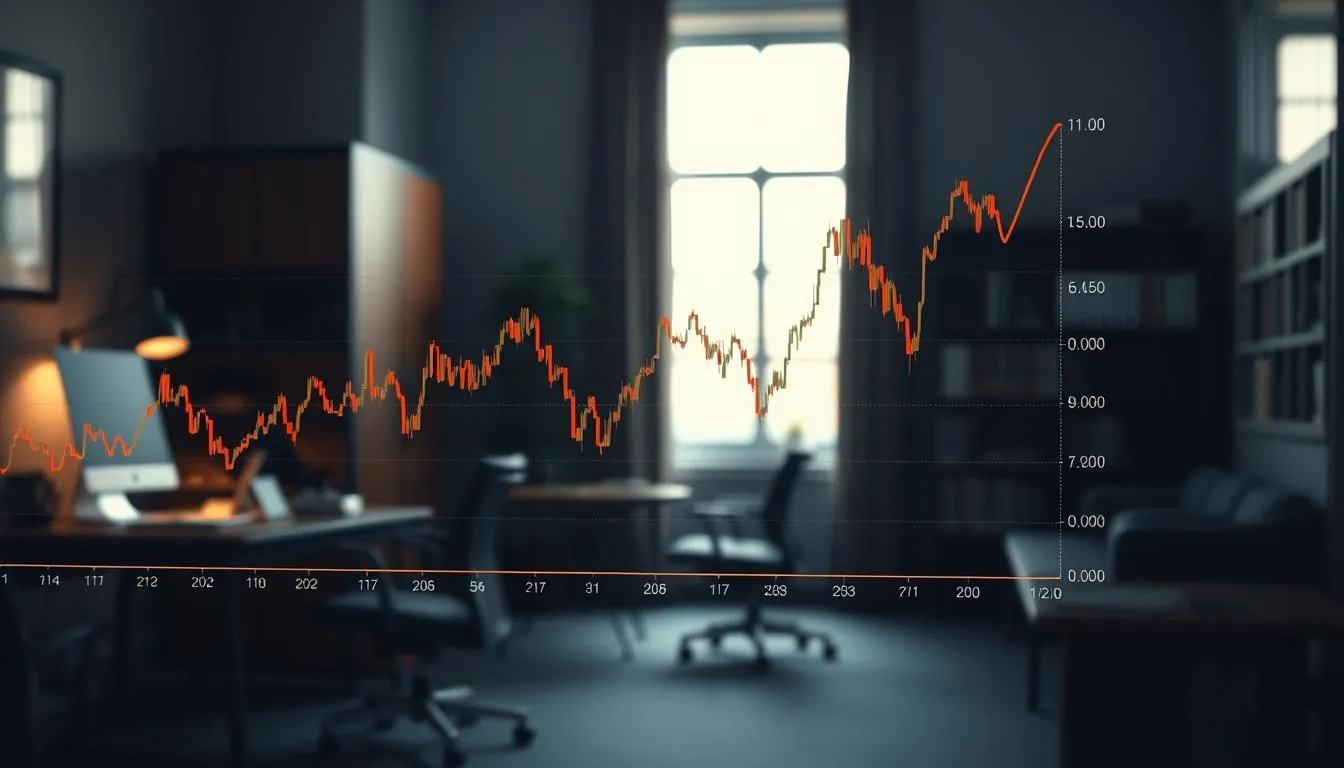Surprising fact: Even after the Fed signaled a shift, the U.S. economy grew at a 3% annualized pace in Q2, leaving borrowing costs stubbornly elevated.
This matters now. A resilient labor market, steady wage gains, and faster retail spending mean the central bank may ease slowly. That keeps the cost of credit firm while savers see better yields.
The trade-offs are real. Homebuyers, car shoppers, and those with credit cards face steadier payments. At the same time, short-term deposits look more attractive.
Through this article we will explain how policy and inflation shape the market and what moves you can make. Expect clear steps on budgeting, saving, and investing with a practical view on risk and return.
Key Takeaways
- Economic strength can keep borrowing costs firm even as policy shifts.
- Households will feel different impacts across mortgages, auto loans, and cards.
- Savers gain from higher yields on short-term instruments and deposits.
- Investors should reassess allocations as durable rate pressure alters valuations.
- Practical moves include shoring up emergency funds and timing major purchases.
Why “higher for longer” is the base case in a future-focused U.S. economy
Data through mid‑year paint a picture of resilience that keeps the central bank cautious.
Fed policy signals
Chair Powell has noted progress on inflation while signaling that cuts may come slowly. Markets and policymakers still debate the pace and magnitude of cuts into 2025.
That distinction matters: a single rate move differs from a full easing cycle. The federal reserve can trim its policy setting yet keep borrowing costs relatively elevated over time.
Slowing but resilient growth
Payroll gains moderated in July–August even as average hourly earnings rose and unemployment dipped. Initial jobless claims fell to recent lows and retail sales jumped in July.
Q2 GDP grew at a 3% annualized clip. Those results support a soft landing scenario and imply cautious, rather than aggressive, shifts in the policy path.

Curve dynamics and yields
Expect a steeper yield curve as short yields fall faster than long yields. Long borrowing costs may decline less quickly if inflation cools gradually toward the 2% target.
This dynamic means mortgage and business financing may stay stickier than many expect, even with easing headlines.
| Indicator | Recent Trend | Implication | Timing |
|---|---|---|---|
| Payrolls | Moderating | Supports gradual cuts | Months to quarters |
| Wages & Unemployment | Wage growth up, unemployment down | Keeps policy elevated | Near term |
| Yields & Curve | Steepening expected | Long yields fall less | Through the year |
For a deeper look at how market expectations evolve with Fed communication, see this analysis of the higher‑for‑longer view.
Interest rates higher for longer: what it means across loans, savings, and the cost of credit
Even modest easing still points to a policy path that keeps consumer credit pricier than a decade ago.
Short-term outlook vs. the past decade
The near-term policy path could leave short-term yields near 4.5% by year-end if several cuts occur in 2024. With further easing into 2025, policy may reach about 3% by year-end.
Why that matters: the 3%–4.5% zone is much above the 1.8% average seen across the 2010s. That gap means many loans and cash products will carry higher borrowing costs than consumers expect.

| Product | Near-term impact | Pass-through speed | Practical tip |
|---|---|---|---|
| Credit cards & personal loans | Moves with short policy | Fast | Prefer fixed payments; watch promos |
| Mortgages | Linked to long yields | Slower | Compare buy vs refinance costs |
| Money market & deposits | Yields stay attractive | Quick on increases, slow on cuts | Lock term where useful |
| Lines of credit | Sensitive to policy swings | Fast | Budget for sustained debt service |
Banks and money market funds often push rate climbs to customers faster than cuts. That pattern supports better deposit returns in the near term.
Bottom line: favor fixed-rate options when possible, budget for steady debt costs, and weigh balance-transfer offers against closing or penalty fees.
Mortgages in focus: translating rates, yields, and spreads into housing decisions
Mortgage shoppers are watching small weekly dips, but the overall level still keeps many buyers cautious.
The 30‑year fixed averaged 6.63% this week, down 9 basis points, while the 15‑year sat at 5.75%, down 10 bps.
Over the past year the 30‑year range ran roughly 6.08%–7.04% and the 15‑year 5.15%–6.27%. Those bounds show how modest weekly moves leave the level elevated compared with recent years.

Why Treasuries don’t set your mortgage
The 10‑year Treasury yield is about 4.22%, creating a typical spread near 2.41 percentage points versus mortgages.
Lenders add that spread to cover servicing, prepayment risk, and credit costs. So an easing by the federal reserve can lower policy pressure without instantly shrinking your mortgage cost.
Buy now or wait?
Inventory is tight and the U.S. median sale price hit $410,800 in Q2 2025, which keeps affordability strained.
If you need a home, consider tactics like paying points, temporary buydowns, or assumable VA/FHA options. Renovation loans such as the FHA 203(k) can widen choices when move‑in‑ready stock is scarce.
- Compare lenders and fees closely.
- Structure offers to limit contingencies but avoid overbidding.
- Plan to refinance if yields move meaningfully lower later.
Investor playbook: positioning portfolios for a higher-for-longer rate regime
A sustained period of firmer policy changes how portfolios earn and preserve capital. Investors should blend tactical moves with a steady process to navigate competing sources of return.
Equities and earnings: balancing offense and defense
When discounting rises, equity valuations face pressure and volatility. Favor cash-generative firms with resilient earnings and clear pricing power.
Dividend strategies, quality factor tilts, and selective sector rotation can help preserve upside while limiting downside in the market.
Fixed income and yield management
Balance duration and quality with laddering or barbell approaches. Use municipal bonds, preferreds, and Treasuries to calibrate exposure to interest moves.
Tax-loss harvesting in munis or preferred securities can offset gains and improve after-tax returns—coordinate this with your tax advisor.
Private credit and secured lending
Private credit can offer attractive spreads: first-lien, senior secured loans have shown spreads near 5%–6% and OIDs around 2% in this decade.
Size allocations carefully, weigh fund liquidity and gating risks, and stress-test holdings against different policy paths.
- Process matters: update your investment policy statement and review your view on risk and return.
- Small steps: rebalance incrementally after market moves and keep cash for opportunistic buys.
Conclusion
Policy is likely to ease slowly, leaving borrowing and saving levels above the prior decade’s norms. ,
Plan assuming modest drift lower in yields while accepting that short-term benchmarks may stay elevated. Savers can lock attractive cash and short-duration options. Borrowers should favor fixed-rate choices and budget with steady payment assumptions.
Homebuyers can use points, buydowns, or assumable loans today and watch spreads if refinancing later makes sense. Investors should mix quality equities with thoughtful fixed income to manage interest risk and stabilize returns.
Keep an eye on inflation, the federal reserve’s timing of cuts, and mortgage spreads. Align moves with your time horizon so the cycle over the next year and decade feels manageable, not disruptive.
FAQ
What does “higher for longer” mean for my wallet?
It means borrowing costs and yields may stay elevated compared with the last decade. Expect higher monthly payments on new loans, more attractive yields on savings and short-term bonds, and a bigger premium for riskier credit. Plan budgets around higher mortgage or auto payments and consider locking in fixed rates if you prefer certainty.
Why do experts say elevated policy is the base case for the U.S. economy?
The Federal Reserve has signaled caution: inflation progress is steady but not fully resolved, so officials favor a measured approach to cutting the target. Combined with resilient jobs and steady GDP growth, policy makers are likely to keep the policy level restrictive until data clearly shows sustained disinflation.
How do jobs and corporate earnings affect the outlook for borrowing costs?
Strong employment and solid corporate earnings reduce pressure to loosen policy quickly. When payrolls stay healthy and companies report stable profits, the Fed can delay cuts, which keeps the cost of credit elevated and influences yields across the curve.
What does a steeper yield curve indicate for consumers and investors?
A steeper curve—where long-term yields fall less than short-term rates—signals investors expect slower easing or persistent inflation risk. Consumers may face relatively high mortgage rates even if short-term lending eases. Investors might prefer short-term instruments for flexibility or lock into higher long-term coupons.
How do current short-term forecasts compare with the last decade?
Short-term benchmarks are notably above the ultra-low levels seen after the 2008 financial crisis. That shift raises the cost of new floating-rate debt and makes high-quality cash alternatives more rewarding than much of the past decade.
What should homebuyers know about today’s mortgage market?
Thirty- and fifteen-year fixed mortgages are priced off Treasury yields plus a spread, so mortgage costs won’t perfectly track Treasuries. Affordability is tighter than in recent years, inventory remains a key factor, and refinancing is less compelling unless rates drop meaningfully from current levels.
Why doesn’t the 10-year Treasury move exactly with mortgage rates?
Mortgages include credit risk, servicing costs, and prepayment uncertainty, which create a spread over the 10-year Treasury. Lenders also price in mortgage-backed security market dynamics and regulatory capital, so mortgage yields typically sit above comparable Treasuries.
Is it better to buy a home now or wait for lower payments?
That depends on personal circumstances. If you value locking a home you want and rates are manageable relative to your budget, buying can make sense. If you can tolerate renting and expect prices or rates to fall, waiting could help. Consider local inventory, expected moves in yields, and your timeline.
What tactics can reduce mortgage costs today?
Options include paying points to lower the rate, pursuing temporary buydowns, exploring assumable loans when available, or widening your search to more affordable locations. A larger down payment or improving credit score can also lower the rate offered.
How should investors position equity portfolios with elevated yields?
Balance offense and defense. Higher yields increase the opportunity cost of holding stocks, especially lower-quality names. Favor companies with durable earnings, strong cash flow, and pricing power while keeping some exposure to cyclical growth that benefits from resilient demand.
What approach works for fixed-income in this environment?
Shorter-duration bonds reduce sensitivity to further policy moves, while high-quality corporates and Treasury bills offer attractive yields with lower volatility. Tax-loss harvesting and laddered maturities can smooth reinvestment risk and capture current yields.
Are private credit and senior secured lending attractive now?
Elevated yields can make private credit appealing for yield-seeking investors, particularly senior secured strategies that offer priority in capital structure. However, assess liquidity, manager track record, covenant strength, and the potential for higher default risk in stressed scenarios.
How will a prolonged policy plateau affect corporate borrowing and investment?
Companies face a higher cost of capital, which can delay expansion and reduce leverage-driven buybacks. Firms with strong balance sheets will have an advantage, while marginal borrowers may see higher spreads and tighter access to credit.
What signs should I watch to know when borrowing costs might fall?
Look for clear, sustained disinflation, weakening labor market data, and Fed messaging that outlines specific cut timing. A decisive drop in core inflation and a moderation in wage growth typically precede meaningful policy easing and lower market yields.
